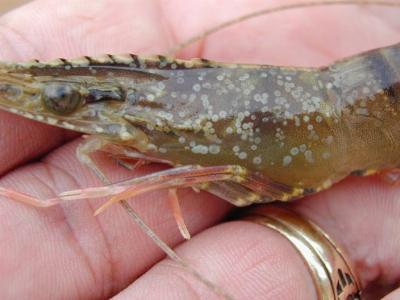How to prevent your shrimps from white spot disease ?

This condition was first reported in Japan in 1993 in shrimp that had been imported from China. The same virus infection was also detected to have infected white shrimps (P.meguiensis, P.indicus) and Tiger Prawn (P.monodon) in India in 1994. Similar disease infection was reported in Taiwan, Japan, Indonesia and Thailand and several species of Penaeus have been affected, including P.merduiensis, P.chinensis, P.indicus and P.japonicus. It is possible that White Spot Disease ( Systemic Ectodermal and Mesodermal Baculovirus “SEMBV” ) may be associated with slightly different viruses in different areas.
Outbreaks spread rapidly through areas, but there is an association between poor environmental condition and outbreaks of White Spot Disease. The characteristic feature of the infection is White spots or patches under the carapace. This may be associated with a red discoloration and many other non-specific signs of gill health, including damaged appendages and external fouling.
Initially, the shrimp are often observed near the surface of the water and they stop feeding recommendations for Yellow head and White Spot Disease. The typical White Spots appear in some, but not all of the shrimp soon after the first signs of gill health and up to 100% mortalities can occur in less than 7 day.
The problem has occurred in post in some cases, it may be difficult to evaluate information on the action of product. Such information is often supplied in scientific terms and may even be intentionally misleading.
Companies selling products for use in shrimp pond should be able to demonstrate that the product has a reasonable chance of improving production.
Even with very effective products there will be no guarantee, since there are no products which can compensate for poor management.
Information on the possible improved production should be based on a large number of farms, if it is not, then the company cannot be sure that the product will have any effect. Farmers should also be wary of misleading information.
INTRODUCTION
1. Mode of Infection
This is water-borne disease spread by host found in the water or ponds, such as zoothamnium, crabs and fish. Birds can also be carrier through its faces.
2. Early Signs of Infection
• Shrimps appear weak and not active.
• The shrimps will appear on the water surface, swimming and gathering around the pond, which makes it easy to collect or be attacked by predators.
• Lost of appetite.
3. Clinical Symptoms
• It color turns pale or reddish.
• Appearance of white spots of 0.5mm-0.2mm diameter, especially at the inner surface of the shell on its head (carapace) and at the tail. Finally, white spots will cover the whole body.
• Death will occur when white spots infect the whole body.
• Death will occur when white spots infect the whole body.
i. 2-3 days as in the young shrimp/juveniles.
ii. 3-10 days for adult shrimps.
• Serious infection will cause the stomach to shrink and damage to the gills.
TREATMENT
So far there is no effective treatment for the disease.
CONTROL OF THE DISEASE
Infected Shrimps and Their Disposal
Farmers are required to follow the advice by relevant officers from the department of Agriculture with regards to the movement and disposal of the infected shrimps. The infected shrimps should never be thrown back into open waters.
INFECTED POND
• Farmers should carry out total cleaning up according the following procedures.
• No water must be discharged from infected pond into the open waters.
• Apply chlorine (Calcium hypo chlorite with 60% active ingredient) at the rate of 3000 kg/hectare and leave for at least 72 hours before the ponds are dried.
• Dry up ponds and leave them exposed to the sunlight for two weeks until the bottom of the pond is dried up. The dried sediments are then collected and suitably disposed off.
• Farmers are advised to stop production (break cycle) for at least one season if their ponds are infected by the disease to avoid
Related news
Tools

Phối trộn thức ăn chăn nuôi

Pha dung dịch thủy canh

Định mức cho tôm ăn

Phối trộn phân bón NPK

Xác định tỷ lệ tôm sống

Chuyển đổi đơn vị phân bón

Xác định công suất sục khí

Chuyển đổi đơn vị tôm

Tính diện tích nhà kính

Tính thể tích ao



 Monitoring pond water quality to improve shrimp and…
Monitoring pond water quality to improve shrimp and…  Study: Inbreeding affects body weight, not survival, in…
Study: Inbreeding affects body weight, not survival, in…